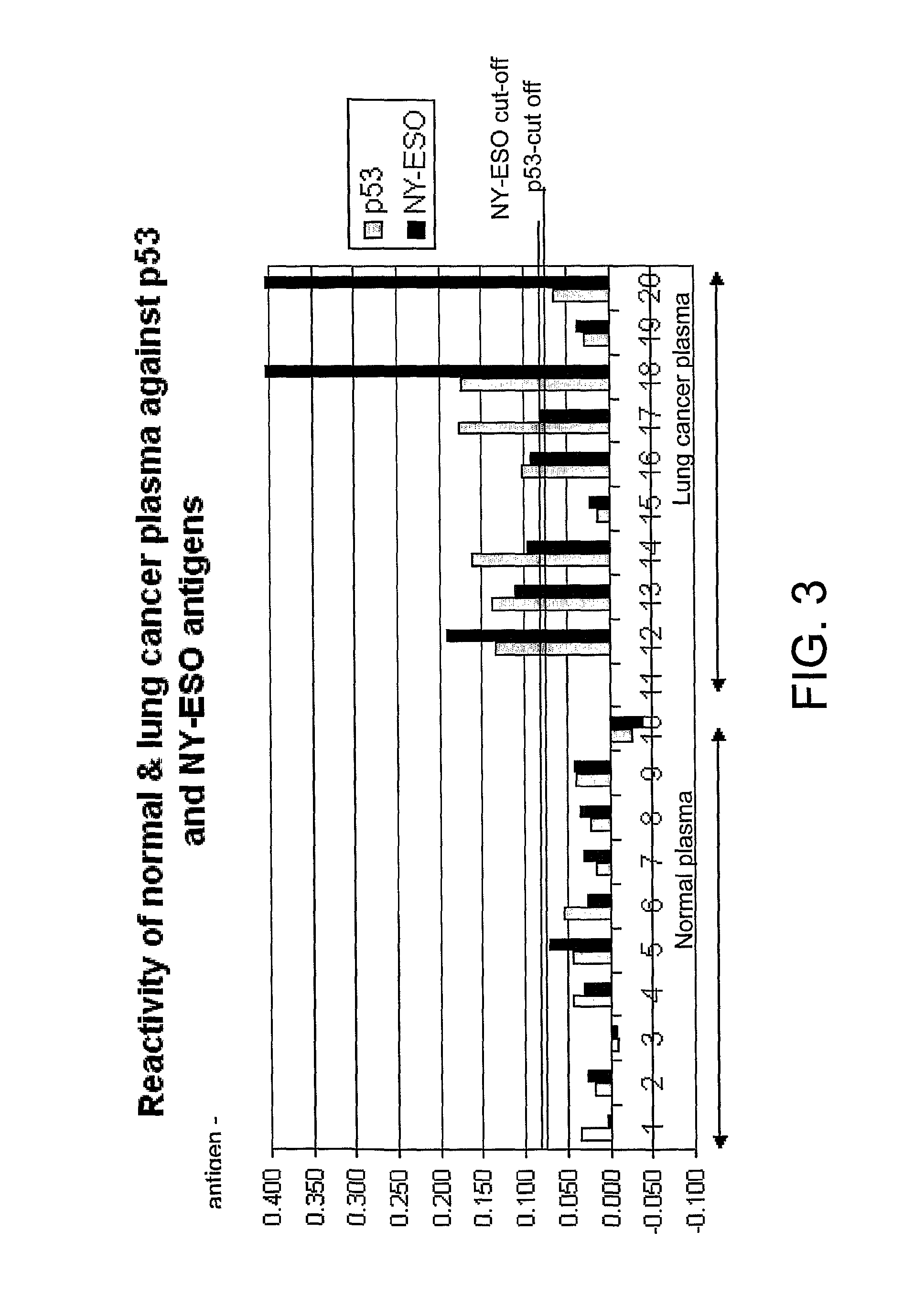Immunoassay Methods
a technology of immunoassay and method, applied in the field of diagnostic or prognostic assay, can solve the problems of high false negative rate, difficulty in scoring true positive, and difficulty in devising a standardised assay methodology, so as to reduce the incidence of false positive and high specificity and sensitivity
- Summary
- Abstract
- Description
- Claims
- Application Information
AI Technical Summary
Benefits of technology
Problems solved by technology
Method used
Image
Examples
example 1
General Protocol for Titration of Antigen in an Autoantibody Assay
[0101]Samples of (biotinylated) tumour marker antigens may be prepared by recombinant expression, following analogous methods to those described in WO 99 / 58978.
[0102]Briefly, cDNAs encoding the marker antigens of interest were cloned into the pET21 vector (Invitrogen) which has been modified to encode a biotin tag and a 6× histidine tag to aid in purification of the expressed protein. The resulting clones are grown in a suitable bacterial host cell (in inclusion bodies), the bacteria lysed and denatured and the expressed antigens recovered via Nickel chelate affinity columns-(Hi-trap, commercially available from Amersham, following manufacturer's protocol). The expressed antigens were renatured by dialysis in appropriate buffer and the yield of expressed protein assessed by SDS-PAGE, western blot and ELISA and quantitated prior to storage.
[0103]The negative control VOL is empty vector (i.e. no cloned cDNA) which still...
example 2
Detection of Autoantibodies in Primary Breast Cancer
[0117]The following data were obtained from a pilot study to assess the sensitivity and reproducibility of a panel of titration autoantibody assays in primary breast cancer (PBC). The study included serum from 17 women with no evidence of cancer and pre-operative serum samples from 20 women with primary breast cancer. Normal and cancer samples were age matched. One normal and three cancer samples had to be removed from the study because they showed evidence of anti-biotin antibody responses and therefore could not be assessed using the assay in its present format.
Approximately 10% of the population is thought to develop an immune response against biotin.
[0118]The assay was carried out according to the protocol given in example 1 using the antigens p53, c-myc, NY-ESO-1 and BRCA2
[0119]FIG. 1 gives examples of curves obtained when the antigen titration assay was used to measure p53 autoantibodies in serum. It can be seen that the canc...
example 3
Detection of Autoantibodies in Lung Cancer
[0123]Analysis of autoantibody responses against 2 antigens (p53 and NY-ESO) in a pilot lung cancer study (10 normal and 9 lung cancer plasma) revealed a detection rate of 78% (FIG. 3).
[0124]The assay was carried out according to the general protocol of example 1, except that plasma samples were used instead of serum.
[0125]Positive patient samples exhibited sigmoidal titration curves similar to that shown in FIG. 1. FIG. 3 shows a comparison of p53 and NY-ESO autoantibody levels in normal individuals and patients with lung cancer as measured using the antigen titration assay. Normal cut-offs were calculated as the mean plus 2 standard deviations of the normal population.
PUM
| Property | Measurement | Unit |
|---|---|---|
| concentration | aaaaa | aaaaa |
| concentration | aaaaa | aaaaa |
| concentration | aaaaa | aaaaa |
Abstract
Description
Claims
Application Information
 Login to View More
Login to View More - R&D
- Intellectual Property
- Life Sciences
- Materials
- Tech Scout
- Unparalleled Data Quality
- Higher Quality Content
- 60% Fewer Hallucinations
Browse by: Latest US Patents, China's latest patents, Technical Efficacy Thesaurus, Application Domain, Technology Topic, Popular Technical Reports.
© 2025 PatSnap. All rights reserved.Legal|Privacy policy|Modern Slavery Act Transparency Statement|Sitemap|About US| Contact US: help@patsnap.com



